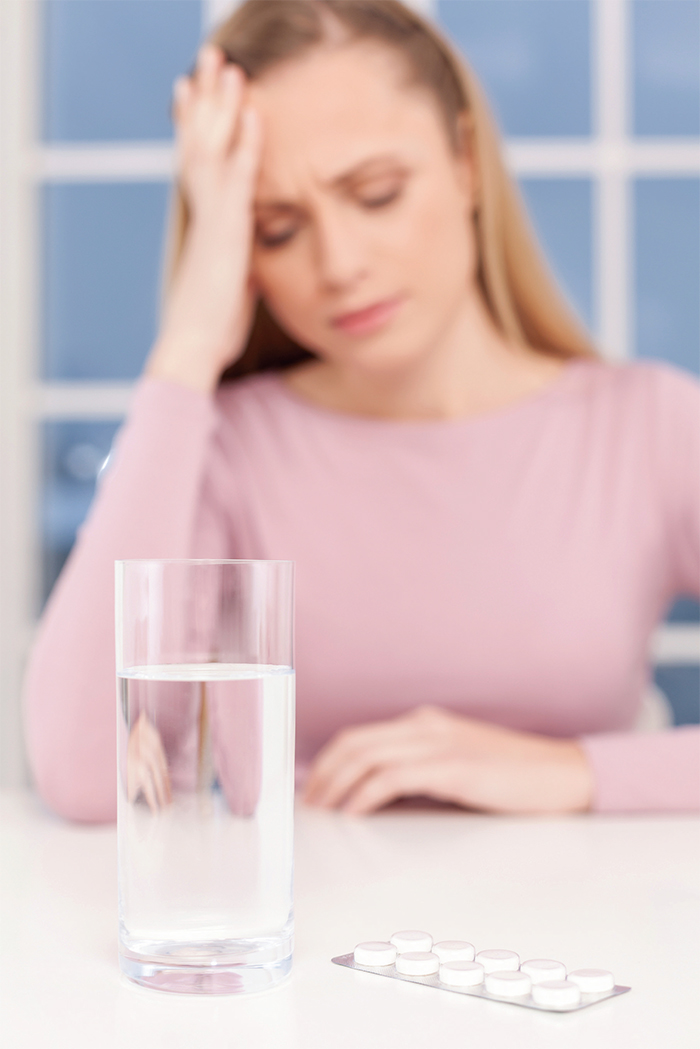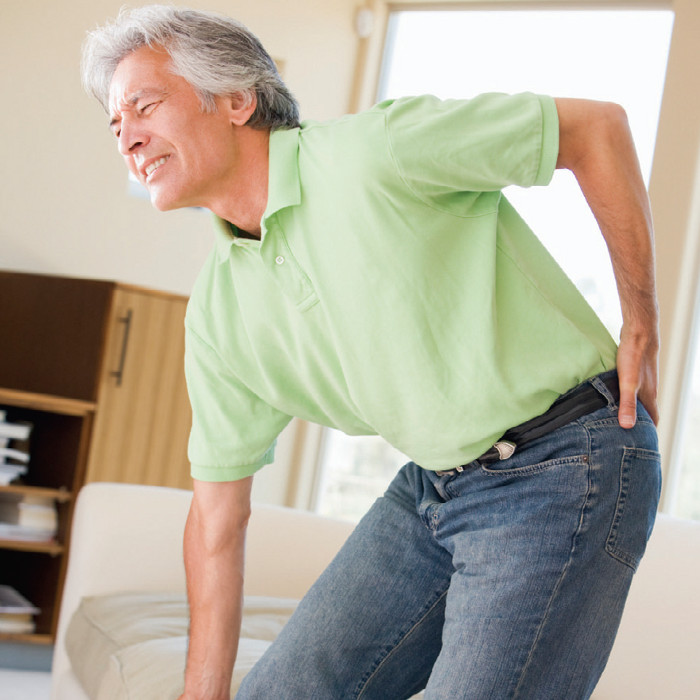Top to toe relief
In Conditions
Follow this topic
Bookmark
Record learning outcomes
Pain can strike for a multitude of reasons, from headaches and period pain to joint pain and sprained ankles. Experts give us the low-down on what to recommend and when

Pain strikes most people from time to time. So it's not surprising that over-the-counter (OTC) painkillers are among the most widely used medicines in the UK. But with so many products available, pharmacy customers may not always know which painkiller to use and when. So here is a top-to-toe guide to help pharmacy staff offer painkiller advice and self-help measures to ease customers' symptoms.
Head
Headaches have a variety of causes, including stress, skipping meals, a lack of sleep and dehydration. Most headaches can be eased with a simple painkiller (e.g. aspirin, ibuprofen or paracetamol). Some people also find cooling forehead sticks or patches to be effective.
However, €if they require painkillers more than twice a week, they should consult their GP,€ says Dr Fayyaz Ahmed, a neurologist at Hull Royal Infirmary. Migraine is more than just a severe headache. The pain is often accompanied by other symptoms such as nausea and increased sensitivity to light and sound.
For maximum effect, customers should take painkillers as early on in an attack as possible. €For migraine, soluble or effervescent products work faster and are more effective than ordinary tablets,€ says Professor Anne MacGregor, honorary professor at the Centre for Neuroscience and Trauma at Barts and the London School of Medicine and Dentistry. €Mouth-dispersible preparations of aspirin, which you suck or chew, have been shown to be effective in clinical trials, and are particularly convenient because they dissolve in the mouth without the need for water,€ she says.
€If a customer is aged 18 to 65, has attacks of typical migraine and doesn't find simple analgesics effective, a pharmacist can advise them about sumatriptan, which is specifically designed to treat the symptoms of migraine.€
Mouth
Toothache ranges from mild discomfort to severe throbbing. Pain is generally caused either by tooth decay, receding gums, or broken or loose fillings.
If customers experience toothache for more than a couple of days, they should make an appointment with their dentist. Paracetamol, ibuprofen or a topical mouth gel containing benzocaine may ease the pain while they wait for an appointment.
Lower abdomen
Up to 90 per cent of women experience period pain. The muscle cramps tend to start off in the lower abdomen and may then spread to the back and thighs. Period pain is usually nothing to worry about and generally improves as women get older. Occasionally, however, persistent or severe period pain can be a sign of an underlying condition such as fibroids or endometriosis.
Ibuprofen and other non-steroidal anti-inflammatory drugs (NSAIDs) such as naproxen tend to be more effective for period pain than paracetamol. This is because they block the production of prostaglandins, which trigger muscular contractions. Not smoking, eating a healthy diet and keeping active can also ease period pain symptoms.
€Customers could try applying either a heat pad or a hot water bottle,€ says Dr Sohere Roked, GP, holistic doctor and bioidentical hormone specialist at The Marion Gluck Clinic. €Taking a bath or shower may ease the pain, while also helping women relax. A relaxing activity such as yoga can help distract them from the feelings of pain and discomfort.
Transcutaneous electronic nerve stimulation (TENS) machines work by releasing small electrical impulses through sticky pads placed on the skin that stimulate the nerves in the pelvic area and help to block pain.€

Up to 90 per cent of women experience period pain
Neck, shoulders and arms
An aching neck and shoulders is often caused by poor posture (e.g. hunching over a computer) or over-exertion (e.g. gardening). As soon as symptoms strike, customers should be advised to keep their neck muscles moving. €Simple neck and shoulder pain should be managed by encouraging and supporting a return to normal movement,€ says consultant physiotherapist and Chartered Society of Physiotherapy (CSP) spokesman Martin Hey.
€Typically, where a patient is significantly stopped from carrying out their day-to-day activities or has persistent distress from symptoms, they should seek the advice of a physiotherapist.€ Topical NSAIDs, containing ibuprofen or diclofenac for example, are an ideal first-line treatment for localised symptoms. These are available as creams, ointments, gels and sprays.
Rubefacients, containing ingredients such as salicylates, camphor or capsaicin, increase the blood flow to the affected area and create a burning or cooling sensation that masks the perception of pain. Massaging these into the skin enhances their effect.
Customers can also try stick-on heat pads or a wheat bag warmed in a microwave. Oral paracetamol or ibuprofen can ease more widespread pain, but customers must stick to the recommended dose.
Children's pain
 The choice and dose of a painkiller needs to be tailored to a child's age and bodyweight €“ check product labels for the correct dosage information. Babies over two months can be given junior liquid sugar-free paracetamol for postimmunisation fever if distressed or unwell, although pain in babies under three months should always be referred to the pharmacist first. Babies aged three months and over (who weigh over 5kg/11lb) can be given junior liquid ibuprofen formulations, although some children (e.g. those with asthma or allergies) may not be able to take it safely.
The choice and dose of a painkiller needs to be tailored to a child's age and bodyweight €“ check product labels for the correct dosage information. Babies over two months can be given junior liquid sugar-free paracetamol for postimmunisation fever if distressed or unwell, although pain in babies under three months should always be referred to the pharmacist first. Babies aged three months and over (who weigh over 5kg/11lb) can be given junior liquid ibuprofen formulations, although some children (e.g. those with asthma or allergies) may not be able to take it safely.
Aspirin isn't suitable for children under 16, unless specifically prescribed by a doctor. Parents should always use a medicine spoon, cup or syringe to measure out medicines €“ household teaspoons don't give an accurate dose. Older children can take chewable paracetamol tablets. Soluble junior products are also available.
Back
 While acute back pain itself isn't life threatening, it can have a significant impact on people's lives. In February 2015, Australian researchers published a list of common back pain triggers. They found that being tired or distracted when performing a manual task significantly increases the risk of developing back pain.
While acute back pain itself isn't life threatening, it can have a significant impact on people's lives. In February 2015, Australian researchers published a list of common back pain triggers. They found that being tired or distracted when performing a manual task significantly increases the risk of developing back pain.
€There are really three things people can do to reduce their risk,€ says Professor Chris Maher, George Institute Musculoskeletal research leader and a senior author on the study. €Firstly, use your back wisely and we have shown here that even brief exposures can be harmful. Secondly, adopt a healthy lifestyle: smoking, being overweight, prolonged sitting and/or being physically inactive are bad for back health. And lastly, stress €“ either at home or work €“ seems to increase your chances of getting back pain.€
Paracetamol is often the analgesic of choice for acute back pain, although this guidance is currently under review following research that concluded that paracetamol was ineffective at treating back pain and osteoarthritis, and could increase the risk of liver problems. (See our Pharmacy Scenario for more on this.) Heat pads and topical or oral NSAIDs may also help, and many healthcare professionals are now recommending drugfree alternatives, such as exercise and physiotherapy.
It was once thought that bed rest would aid recovery from a bad back, but it's now recognised that people who remain active are likely to recover more quickly. €This may be difficult at first if the pain is severe,€ says Dr Ajai Seth, sport and exercise medicine expert at Queen Elizabeth Hospital NHS Trust. €But it's important to try to move around as soon as possible, whilst aiming for a little more each day.€
Hips and knees
Arthritis affects millions of people in the UK. It's not just a disease of old age, as children and young people are affected too. Rheumatoid arthritis is triggered by inflammation in the joints and is usually treated with prescribed anti-inflammatory medicines.
Osteoarthritis is caused by wear and tear on the joints, especially the hips and knees. Exercise and weight loss are the first-line treatments. €Joints are designed to be used,€ says Dr John Dickson, a GP in North Yorkshire with a particular interest in musculoskeletal conditions and arthritis.
€So customers should be advised to do just that €“ just a little more walking and then to gradually increase the amount. Exercise doesn't do harm, but will strengthen the muscles that protect joints. Evidence shows that a weight loss of 10 per cent can give a 50 per cent reduction in pain, especially in knee and hip arthritis.€
Some people find their arthritis pain is relieved with OTC painkillers. €NSAIDS such as naproxen are often prescribed, or in the case of ibuprofen, bought over-the-counter for both rheumatoid and osteoarthritis due to their anti-inflammatory effects,€ says Dr Rod Hughes, consultant rheumatologist at St Peter's NHS Hospital in Surrey.
€Paracetamol may be used in combination with NSAIDs as a 'top up' painkiller, but is unlikely to be used on its own for inflammatory arthritis due to its lack of anti-inflammatory properties. Although ibuprofen is an NSAID, it may not be strong enough in isolation to manage rheumatoid arthritis. In this case, stronger NSAIDs or escalation to diseasemodifying drugs such as methotrexate may be necessary.€
Customers need to be careful if they are taking oral painkillers regularly for arthritis pain. €Many patients with mild or moderate arthritic pain do get some relief from OTC oral analgesics, but care must be taken, as these are not without risks and side effects,€ says Dr Dickson. €Topical treatments should always be tried first to relieve arthritis pain as they are safer than oral ones and can be applied directly to the painful joint.€
There's limited evidence for the use of dietary supplements in osteoarthritis management, but some customers may find these helpful. €Natural supplements prove very popular in those with joint pain,€ says Dr Hughes. €Options include fish oils (omega-3), chondroitin, glucosamine and rosehip extracts, with varying levels of clinical evidence for each.€
Bumps and bruises
Bumps and bruises don't always appear straight away after an injury, but the skin can still feel painful and tender. If someone has a bump or bruise, they should hold something cold against the skin straight away (for 20 to 30 minutes) to encourage healing and reduce pain and swelling. This could be a bag of peas or ice wrapped in a cloth, a cold compress or a cold pack.
Most bruises take around two weeks to disappear. If a bruise is painful, customers can take ibuprofen or paracetamol. Aspirin should be avoided, however, as this slows down blood clotting and can prolong bleeding. Arnica cream or gel may also help to relieve swelling and pain associated with bruises. If the bump or bruise becomes very painful or swollen, customers should seek medical advice.
Ankles
Sprains and strains can be triggered by falls or sporting accidents. They are usually managed at home with self help measures and hot or cold therapy. €When an ankle sprain occurs, in the first instance patients should apply the PRICE principles,€ says Martin.
€This means Protect, Rest, Ice, Compress, Elevate. Where significant pain or ability to walk normally is affected for more than 48 hours, patients should look to be assessed by a physiotherapist.€ For the first 72 hours after a sprain or muscle strain, customers should avoid HARM: Heat (e.g. hot baths, saunas or heat packs), Alcohol, Running, Massage.
€Most healthcare professionals recommend you shouldn't stop using a sprained joint,€ says Dr Seth. €The injury will heal quicker if you begin to move the joint as soon as you are able to do so without experiencing significant pain. However, an exception may be made in cases of severe ankle sprains.
Cold therapy should be used with an initial injury, as it reduces blood flow to the affected area and slows down pain transmission. Heat therapy is usually more effective at treating chronic muscle pain or sore joints caused by arthritis and delayed onset muscle soreness.€
Temperature's rising
When the body's temperature rises above 37.5ºC (99.5F), it is classed as a fever. A fever is usually a sign that the body is fighting an infection. However, it can also be associated with an underlying condition such as rheumatoid arthritis, inflammatory bowel disease and hyperthyroidism.
According to NHS Choices, it isn't necessary to take medicines to lower a fever if it isn't causing any distress. However, high fevers are often accompanied by headaches, aching muscles and fatigue, which can make people feel very uncomfortable and prevent them from sleeping. A fever can be lowered with paracetamol, ibuprofen or aspirin (depending on suitability).
A fever usually lasts for two to three days before subsiding. Prolonged fever may cause dehydration, especially if there's excessive sweating, so it's essential that the patient drinks plenty of fluids, especially in the case of babies and older people. A persistent or prolonged fever needs to be investigated for an underlying cause, especially if other symptoms are present.
For maximum effect, customers should take painkillers as early on in an attack as possible
